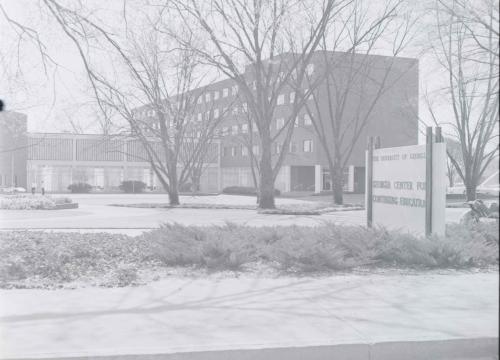Georgia Center for Continuing Education – UGA 1640 (1955, 1987; Category 2) The Georgia Center for Continuing Education is located at the corner of Lumpkin and Carlton streets and was made possible through a 1953 grant from the W. K. Kellogg Foundation and matching funds from the State of Georgia. Constructed in 1956 and opened in 1957, the center was an early Mid-Century Modern structure built on campus. The building is five stories tall and contains meeting and classroom space, dining and banquet facilities, and lodging. The center offers residential conferences and short-courses, and many other programs for adult education. In 1984, the Kellogg Foundation provided funds for expansion of the facility, doubling the size of the building.
The original portion of this modern brick building was designed with glass and an exposed concrete structure at its first floor level and a crisp brick mass with large, horizontal steel windows with cantilevered steel awnings shading its hotel rooms on the floors above. The later expansion is of contemporary design and was completed in a complementary and creative manner. The building is significant for its association with the Mid-Century Modern and for the overall quality of its design, and is assessed as Category 2.
Landscape Resources
Landscape features associated with this character area include an access road leading east from South Lumpkin Street, a circular drop off area from Carlton Street, paved walks, and plantings located around the Georgia Center and within the space contained by the U-shaped building.
Courtyard garden (1955, Category 5). The courtyard of the Georgia Center originally featured a design by Thomas D. Church (1902–1978), a notable landscape architect whose signature style reflected the modernist movement of the 1950s. Church is credited with starting the modern movement in landscape architecture eventually known as “California Style.” The Georgia Center is believed to have been his only institutional design in the South.363 The garden has since been substantially beyond recognition and has lost integrity.


